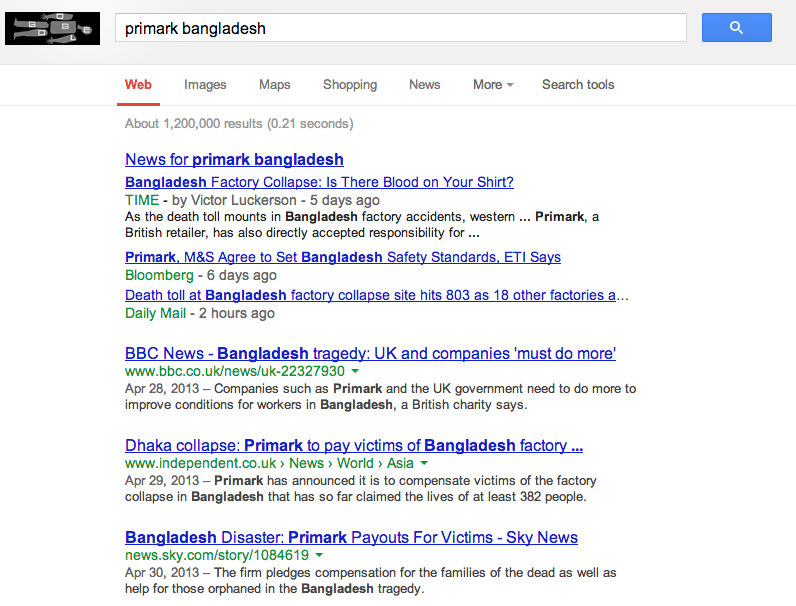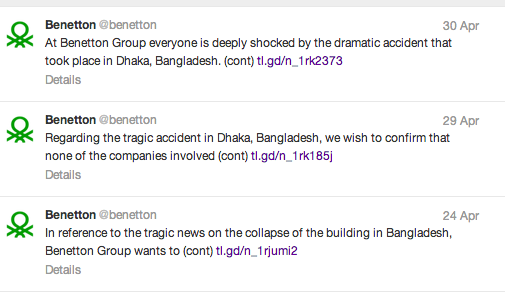By: Ilaria Pasquinelli, Twitter: @ilaria78, international marketing consultant for the textile and fashion industry.
2 weeks after the Rana Plaza’s disaster in Bangladesh, the death toll has risen to 921 and the fire broke in another garment factory last night killing 8.
Brands like Primark, C&A, Benetton, Matalan, Mango, Bonmarché, and Joe Fresh have been found producing in the 5 factories with production units based in the building. It is easy to notice the presence of the usual suspects (e.g. Primark), notably presiding the low end of the high street, in such a disaster; however, also brands like Benetton and Bonmarché, the higher end of high street, are involved. If we consider the price of a basic t-shirt or a vest, as an example, Wal Mart, Matalan, Primark and Joe Fresh sell it between £3 and £4 while Benetton and Bonmarché are more around the £10-£15 range. It is therefore clear that poor working conditions are not so much associated with low prices; they are indeed connected with the endemic outsourcing phenomenon so common in today’s fashion companies sourcing strategies.

But how have these fashion brands reacted to, possibly, the worst known disaster in the history of the global apparel industry?
It goes without saying that, from a business point of view, this is certainly a brand disaster that means financial losses and reputation damage. The interested companies will most probably have to invest substantially more in PR to re-gain reputation, than the goods that were supposed to be delivered and will never reach stores were worth in first place.
Just to give a measure of the brand reputation disaster, googling for the individual the brand names involved in the accident followed by the term “Bangladesh”, the following results come up:
-Jow Fresh: 18,200 news and 21.5 million hits;
-Primark: 15,300 news and 1.2 million hits;
-Benetton: 7,480 news and more than 1.2 million hits;
-Bonmarché: 2,280 news and 451,000 hits;
-C&A: 1,330 news and 291,000 hits;
-Matalan: 931 news and 89,000 hits.
Even if we remove from these statistics non relevant content, it is clear that this is at the moment one of the hottest topics in online communities and news media.
So how have these fashion brands reacted?
The brands that have been more reactive and who accepted their responsibility have been Primark and Joe Fresh. There is little doubt: These brands have learned the power of telling the truth. To be specific: less than 24 hours after the accident, Primark communicated through social media that: “[…] Primark confirms that one of its suppliers occupied the second floor of the eight storey building, which housed several suppliers to the garment industry making clothes for a number of brands”.
The post received more than 500 Facebook likes even though more than 800 comments blamed the high street retailer for the accidents and their unsustainable business model.
After 5 days, on April 30 the brand confirmed in another post that it will provide a compensation for the victims of the disaster that worked for them which will include “[…]mprovision of long-term aid for children who have lost parents, financial aid for those injured and payments to the families of the deceased”.
Joe Fresh stated that, “besides support to the victims’ families, work safety issues will be addressed with a new standard ensuring that products are made in facilities that respect local construction and building codes and a commitment to have its people on the ground for regular inspections“.

A brand thought that has
a) neither learned the power of truth and
b) nor properly managed its communication, particularly through social media,
is Benetton.
The brand has promptly dissociated itself from the Bangladeshi disaster tweeting on the day of the disaster a cold company statement saying that “In reference to the tragic news on the collapse of the building in Bangladesh, Benetton Group wants to clarify that none of the companies involved are suppliers to Benetton Group or any of its brands.”
Four days later, on April 29, the company had to admit that “… a one-time order was completed and shipped out of one of the manufacturers involved several weeks prior to the accident. Since then, this subcontractor has been removed from our supplier list […].” after photos of Benetton labelled garments and orders in the brand’s names emerged from the debris.
Only after ascertaining its involvement in the tragedy, Benetton decided finally on April 30th to express condolences to the families of the victims.
Benetton may have not known about the sporadic orders at the Bangladeshi factory based in the Rana Plaza, given that they work with some 700 suppliers and the common sub-contracting habit in the industry.
The overly quick response, based on assumptions rather than facts, would have triggered at least a ‘wait and see’ reaction though, rather than a storming declaration of innocence. Further, some compassion for those affected by the tragedy would have been in place instead of a mere cold corporate statement.
What about the other brands?
Apart from sporadic brief expressions of condolences in the news section of the corporate web sites, there is not much to say.
The incident was mostly ignored. Instead, posts about sensational discounts (“it is your LAST CHANCE to get 20% off everything including sale!!!” Source: Bonmarché Facebook page, April 25th) or new spring/summer collections (“linen is a timeless classic – comfortable yet stylish”, Source: Matalan Facebook page, April 24th) received the spotlight during the days of the disaster.
A slightly surprising conclusion hence is, that suddenly brands like Primark or Joe Fresh show leadership and represent best practises on how to deal with such disasters from a communication point of view within the industry. However, none of the considered brands represent best practises in absolute terms.
Their posts no doubt were written by press officers – they read like excerpts of press releases: consumers’ concerns were not addressed, questions were not answered, and the information released was not very factual.
In a nutshell, not in a single case has there been an open conversation with angry consumers. Indeed, not even a try at it. It would have been innovative, and a nice touch on top of that, to see the brands’ representatives answering consumers’ questions directly through, for instance, live chats. Or it could have been useful to read more in-depth explanations through dedicated web sites, blogs or FAQs.

